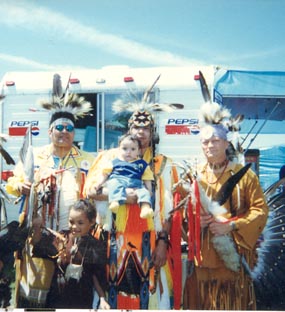American Indian Studies Department - Ojibwe LanguageUniversity of Minnesota - This page explains a few elements of the Ojibwe language course series (AmIn 1021, 1022, 1023, 3024, 3025 and 3028), the content within each course and other course-related information.
Anishinaabe <--> English Translator On-LineCollege of St. Scholastica - Word Translators English to Anishinaabe: Anishinaabe equivalent: Anishinaabe to English: English equivalent. >> THE TRANSLATOR IS TEMPORARILY OFF-LINE, BUT WILL BE BACK ON-LINE HOPEFULLY THIS FALL <<
Anishinaabemowin LynkThis booklet was written to assist students who wish to learn the Anishinabe language. The author does not claim that the students will learn the Anishinaabe language solely from this written material. It is a tool which may help the students learn when used with other materials.
Assembly of Manitoba Chiefs - EFAWith sound wav's for Greetings -- The Assembly of Manitoba Chiefs and the Minister of Indian and Northern Affairs Canada signed the Framework Agreement on Indian Education in Manitoba on December 5, 1990. The purpose of the Framework Agreement is to develop formal arrangements on education based on community-identified educational needs. Under the terms of the Framework Agreement Initiative, the Assembly of Manitoba Chiefs are currently negotiating long-term changes for First Nations education and establishing an implementation plan for setting up a new education system under First Nations Jurisdiction.
Chippewa [ Ojibwe ] [ojiipewa] Language ~ Anishinabemowin ~ This Site is Dedicated to the Preservation of Anishinabebimadissiwin.
Elementary English to Ojibwe Translator An On-Line Translator - It is in the very early days of its cloning from the Odawa site. Through Albion Cpllege.
FNFP - First Nation Forestry ProgramIntroduction in Ojibwe as well as in Salish, Cree & Micmac
H-AMINDIAN: Discussion Threads: Long Knves: Indian Ethnonyms for non-Indians
Key to Ojibwe Place NamesDr. Brian R. Donovan abstract portrait by son Trevor at age 4 Associate Professor of English, Bemidji State University (BSU), Bemidji, Minnesota, USA
LCTL:OjibwaThe following list contains information about colleges and universities in North America that teach Ojibwa. The institutions are listed alphabetically, with information about course levels and availability, and the name of a contact person at the institution.
Learn AnishinaabemowinAnishinaabemowin, the language of the Anishinaabe nation, is one of the oldest and most historically important Native American languages in North America, but it is in danger of becoming extinct if not passed on to a new generation. In earlier times, the language was passed on orally from a tribe’s elders to its younger members, but in more recent times, this practice has fallen victim to outside influences.
Learning OjibweThe following comprehensive list of learning resources for Ojibwe has been prepared for the SSILA Learning Aids files by Rand Valentine, who teaches linguistics and Ojibwe at the University of Wisconsin, Madison. (Many thanks, Randy!) The dialects covered include: Algonquin, Anishinaabemowin, Central Ojibwe, Chippewa, Eastern Ojibwa, Nipissing, Nishnaabemwin, Northern Ojibwe, Odawa, Oji-Cree, Ojibway, Odawa, Ottawa, Saulteaux, and Severn Ojibwe.
Let's Speak Ojibwe: pronunciation chart Ojibwe is a branch of the Algonkian language family. This web site used the Double Vowel system to write the language. Although the letters used are taken from the English alphabet, they represent Ojibwe sounds, not English sounds. In the examples below, Ojibwe sounds and English approximations of the Ojibwe sounds are given. However, it is always best to consult a native speaker for the best pronunciation. Correct pronunciation is important, mispronouncing a word can completely change its meaning.
Nanichi's Anishinaabe DictionaryThe Anishinaabe people are more commonly known as the Ojibwe/Ojibwa/Ojibway people. To others, they are known as the Chippewa, in which case the Ojibwa name was mispronounced. If one says "o'chippewa" you can easily see that the two names are simply different pronounciations. You might be interested to know that to others, they are known as the Salteaux and/or the Soto. This page is also here.
NAT-LANG (1994): Ojibwe language-learning materials available.People interested in Ojibwe language study materials may want to call Ojibwe Mekana. They have two (maybe three by now) cassette-based courses available, and they're pretty good. I've had both the Basic and Advanced sets for awhile now, and I'm pleased with them, so I'm passing the word along.
Niizh Ikwewag - Two WomenPoint to any part of the Ojibwe text below with your mouse and an appropriate grammatical/lexical note will appear on the status line at the bottom of your browser window. (This requires a Java-enabled browser.) English translation available here.
Ojibway Indian LanguageVowel Pronunciation when and where - Past tense: Time expressions: Questions with "AANIISH PII": More questions: Useful Expressions: Inanimate nouns: Locative forms: Sentence Patterns: Verbs: and tons more!!
Ojibwe Language and Culture: Language, by Nancy VogtWelcome to Ojibwe language and culture. This is not meant to include a complete dictionary or tutorial to learn the language, or to be the final word on cultural issues but I hope it will be a pleasant and interesting introduction. Language essays, Cross-cultural materials, bibliography of further references.
Ojibwe Language Society HomepageOur Ojibwe Language Table is open to the community. Join us every Monday during the school-year for food and Ojibwe conversation. There's room at the table for beginners and fluent speakers.
Ojibway Learner PageThis page is for fellow learners of the Anishinabe language (Ojibway). At present, it consists of a couple of puzzles I developed for fun, my personal language resource holdings and a short essay about my language learning experience. At the moment, this page is limited by my HTML knowledge and available time. Ojibway language puzzle
Ojibwe Native Language Material - Bibliography
The Way We Speak - CHAPTER 7: OJIBWE* Established in 1985, MANL promotes Native languages retention by stimulating awareness of the importance of Native languages to cultural development. In partnership with local communities MANL (Manitoba Association for Native Languages, Inc.) works to keep six aboriginal languages alive. Ojibwe, Cree, Dene, Dakota, Island Lake Dialect, and Michif.
back to top
Books, News & Authors

